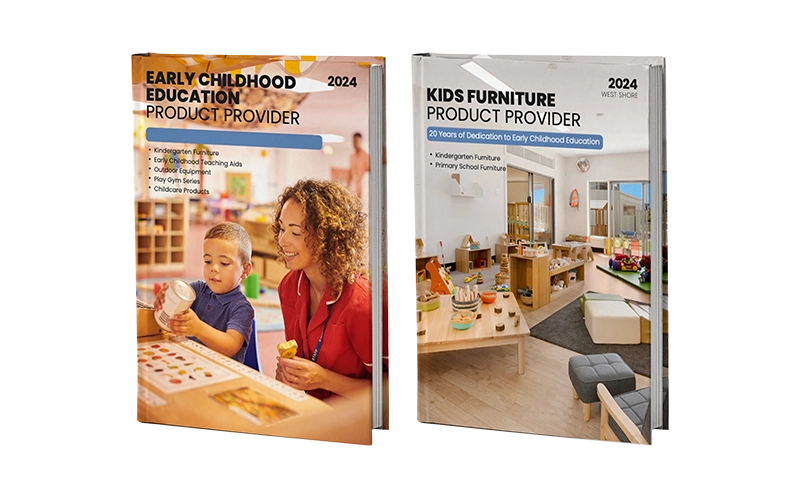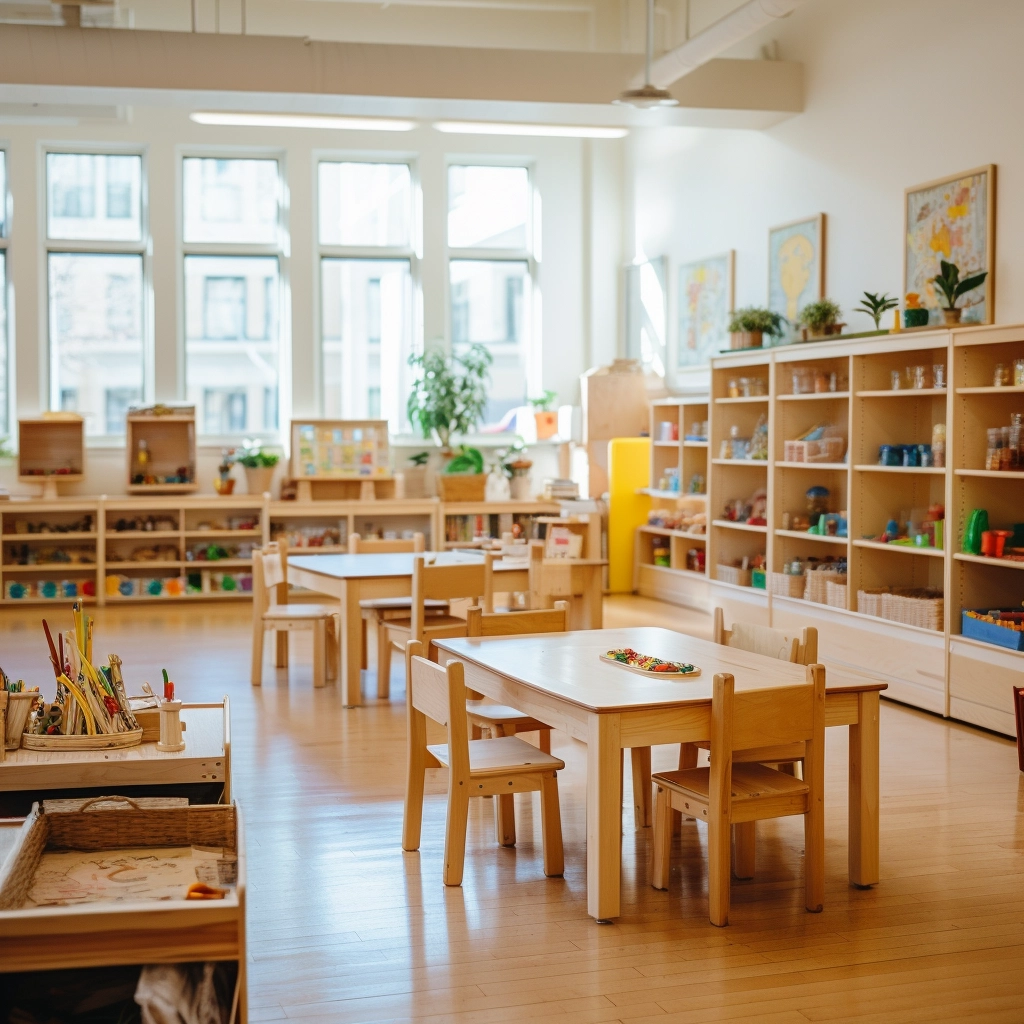What makes a preschool classroom design truly supportive of young children’s growth? Is it the cheerful colors, the child-friendly furniture layout, or the thoughtful arrangement where every corner invites children to play and learn? Designing an adequate space goes beyond decoration—it’s about crafting an environment where children feel safe, engaged, and free to explore.
In 2025, educators must carefully consider essential Preschool Classroom Setup factors to achieve a balanced space that supports safety, active learning, and flexibility. A well-designed classroom takes into account how children move, interact, and grow—encouraging independence, social development, and natural curiosity through purposeful design choices.
This article explores the six most important elements of modern preschool classroom design, helping you build a learning environment that meets the needs of both children and teachers.

การจัดห้องเรียนก่อนวัยเรียนที่ดีควรเป็นอย่างไร?
“สิ่งแวดล้อมคือครูคนที่สาม” — ลอริส มาลากุซซี ผู้ก่อตั้งแนวทางเรจจิโอเอมีเลีย
เมื่อพูดถึงการศึกษาในช่วงปฐมวัย ห้องเรียนไม่ได้เป็นเพียงฉากหลังเท่านั้น แต่ยังเป็นส่วนหนึ่งที่มีส่วนร่วมในเส้นทางการเรียนรู้ของเด็กอีกด้วย ห้องเรียนระดับก่อนวัยเรียนที่ออกแบบมาอย่างดีเปรียบเสมือนผู้นำทางที่อ่อนโยน กล่าวคือ ห้องเรียนจะพูดโดยไม่ใช้คำพูด เชิญชวนโดยไม่กดดัน และสอนโดยไม่ต้องบรรยาย
ลองนึกภาพพื้นที่ที่ชั้นวางของ พรม และมุมต่างๆ ล้วนส่งเสริมความอยากรู้อยากเห็น ความร่วมมือ และความมั่นใจ เฉกเช่นสวนที่เตรียมไว้เพื่อการเติบโต การจัดโรงเรียนอนุบาลที่ดีจะไม่ทำให้เด็กๆ เหนื่อยล้า แต่จะช่วยเสริมสร้าง เด็กๆ จะได้รับอิสระในการเคลื่อนไหว ความปลอดภัยในการสำรวจ และโครงสร้างที่ช่วยให้เจริญเติบโต
เพื่อให้บรรลุความสมดุลนี้ ครูจะต้องพิจารณาปัจจัยสำคัญในการจัดห้องเรียนก่อนวัยเรียนอย่างรอบคอบ ซึ่งเป็นองค์ประกอบพื้นฐานที่ทำให้ห้องเรียนใช้งานได้จริงและสร้างแรงบันดาลใจได้ ในหัวข้อต่อไปนี้ เราจะสำรวจปัจจัยสำคัญ 6 ประการที่หล่อหลอมห้องเรียนก่อนวัยเรียนให้กลายเป็นสถานที่ที่ทั้งการเรียนรู้และวัยเด็กสามารถเติบโตได้อย่างเต็มที่
ปัจจัยที่ 1 ของการจัดห้องเรียนก่อนวัยเรียน: พื้นที่ทางกายภาพ
The physical space in a preschool classroom is not merely about square footage—it is the architectural foundation of a child’s learning journey. A well-designed layout does more than organize furniture; it shapes how children move, interact, focus, and explore within the environment.
A practical classroom layout balances openness and boundaries. Children should have enough room for indoor activities—such as block play, circle time, and dramatic play—while still experiencing a sense of structure through clearly defined zones. For example, large open spaces encourage collaboration and group exploration, while smaller, bordered areas like a reading corner or art station promote focus and calm.

Flexibility is key. Incorporating lightweight, movable furniture allows teachers to adapt the space for different purposes throughout the day. A classroom that can transition smoothly from active movement to quiet reflection supports a wide range of learning styles and energy levels.
Design also plays a role in managing noise levels and acoustics, ensuring that the environment remains calm and conducive to focused learning. Moreover, natural light and access to outdoor learning spaces can expand the sense of space and bring in sensory richness that deepens engagement.
In short, the physical environment becomes an active facilitator—encouraging independence, guiding behavior, and supporting developmentally appropriate learning throughout the day.
ปัจจัยที่ 2 ของการจัดห้องเรียนก่อนวัยเรียน: การตกแต่งและความสวยงามทางสายตา
Decorating a preschool classroom is not just about making it look attractive—it’s about creating an intentional, stimulating environment that supports learning and emotional well-being. As an essential Preschool Classroom Setup Factor, thoughtful decor can spark creativity, encourage exploration, and help children feel connected to their space.

Color and texture significantly influence how children engage with their surroundings. Bright, cheerful tones can energize the room and foster a welcoming atmosphere, while natural hues and soft textures help create a calming balance. Incorporating a mix of both allows different areas of the classroom to serve distinct purposes—some vibrant and active, others quiet and soothing.
Visual elements should serve both aesthetic and educational purposes. Alphabet charts, number lines, visual schedules, and thematic bulletin boards offer visual reinforcement of key concepts. Adding maps, seasonal displays, or learning posters turns blank walls into meaningful learning tools.
Decor should also be personal and purposeful. Featuring children’s artwork, family photos, or classroom projects promotes a sense of ownership and belonging. These visual displays affirm each child’s value and contributions to the classroom community.
In short, Preschool Classroom Setup decisions about decor should balance beauty, function, and meaning—creating a visually rich space that nurtures imagination and learning every day.
ปัจจัยที่ 3 ของการจัดห้องเรียนก่อนวัยเรียน: เฟอร์นิเจอร์และอุปกรณ์ที่เหมาะสมกับวัย
Choosing age-appropriate furniture and equipment is essential for creating a classroom that supports both safety and development. Preschoolers require furnishings that match their physical size, developmental abilities, and growing need for autonomy. Every chair, table, and shelf should contribute not only to comfort but also to learning and independence.

Well-designed preschool furniture should be low in height, sturdy, และ free of sharp edges. Tables and chairs should allow children to sit with their feet flat on the floor and arms resting comfortably, promoting proper posture and reducing fatigue. Storage units and shelves must be within easy reach, encouraging children to access and return materials independently—an essential part of building responsibility and routine.
Montessori-style furniture is a popular choice in early childhood settings, as it emphasizes child accessibility and functional simplicity. Open shelving, child-sized sinks, and light, movable pieces help create an environment where children feel in control of their learning space.
When it comes to equipment and materials, selections should align with children’s cognitive, sensory, and motor skill development. Items such as tactile toys, manipulatives, child-safe art supplies, and simple tools like scissors or brushes should be safely usable without constant adult assistance.
In short, appropriate furniture and equipment do more than fill a room—they empower children to move, choose, and participate in daily activities with confidence and ease.
Preschool Classroom Setup Factor 4:Safety and Accessibility
A critical Preschool Classroom Setup Factor is ensuring both safety and accessibility throughout the learning environment. Young children thrive in spaces where they can move freely, explore confidently, and engage with materials without unnecessary risks.

To ensure safety, classrooms should be free of tripping hazards, with walkways kept clear and open. All furniture should have rounded edges and be made of non-toxic, durable materials. Electrical outlets must be covered, and heavy items should be securely anchored. Regular safety inspections help maintain a hazard-free space and ensure compliance with early childhood safety standards.
Accessibility is equally essential. Young children should be able to reach learning materials, use furniture, and navigate between activity zones without adult intervention. This means providing low, open shelves, step stools, and marked paths. Doorways, bathrooms, and sinks should accommodate all learners, including those with mobility challenges.
Adequate supervision is also part of this Preschool Classroom Setup Factor. Teachers should be able to see every corner of the room without obstruction, allowing for both freedom and guidance. Low dividers and open layouts support clear visibility while still creating defined learning zones.
By prioritizing both safety and accessibility, educators create an inclusive and secure environment where children are free to explore, take initiative, and participate fully in daily activities—laying the foundation for confident and independent learning.
ปัจจัยที่ 5 ของการจัดห้องเรียนก่อนวัยเรียน: การจัดระเบียบพื้นที่การเรียนรู้
ห้องเรียนที่จัดอย่างเป็นระเบียบจะสร้างสภาพแวดล้อมที่คาดเดาได้ สงบ และสร้างสรรค์ การจัดห้องเรียนที่ชัดเจนไม่เพียงช่วยให้ครูจัดการพื้นที่ได้อย่างมีประสิทธิภาพเท่านั้น แต่ยังช่วยให้เด็กๆ มีอำนาจในการเป็นเจ้าของสภาพแวดล้อมของตนเองอีกด้วย เด็กๆ จะพัฒนาความรู้สึกถึงความรับผิดชอบ ความเป็นอิสระ และสมาธิที่มากขึ้นเมื่อทุกสิ่งมีที่ของมันและทุกพื้นที่มีจุดประสงค์
ห้องเรียนก่อนวัยเรียนที่มีประสิทธิผลโดยทั่วไปจะถูกแบ่งออกเป็นโซนการเรียนรู้ที่แตกต่างกัน แต่ละโซนได้รับการปรับแต่งให้เหมาะกับกิจกรรมประเภทเฉพาะ
โซนการเรียนรู้ร่วมในห้องเรียนก่อนวัยเรียนประกอบด้วย:
- พื้นที่อ่านหนังสือ – พื้นที่เงียบสงบแสนสบาย พร้อมหนังสือและเบาะรองนั่งสำหรับอ่านหนังสือคนเดียวหรือร่วมกัน
- พื้นที่เล่นละคร – พื้นที่เล่นตามบทบาทพร้อมเครื่องแต่งกายและอุปกรณ์ประกอบฉากเพื่อเสริมสร้างการเล่าเรื่องจินตนาการ
- พื้นที่ศิลปะและความคิดสร้างสรรค์ – สำหรับการวาดภาพ การระบายสี และงานฝีมือ โดยใช้สื่อที่เด็กเข้าถึงได้
- พื้นที่เล่นสัมผัส – มีทราย น้ำ หรือวัตถุที่มีพื้นผิวเพื่อให้สำรวจได้ด้วยตนเอง
- พื้นที่บล็อคและก่อสร้าง – สำหรับการสร้างด้วยบล็อกหรืออุปกรณ์เพื่อเสริมสร้างทักษะการเคลื่อนไหวของกล้ามเนื้อมัดเล็ก
- พื้นที่คณิตศาสตร์และการจัดการ – มีเครื่องมือนับ การจัดเรียง และการใช้ตรรกะ
- พื้นที่วิทยาศาสตร์และการค้นพบ – รวมถึงวัตถุในธรรมชาติ เครื่องมือขยาย และการทดลองง่ายๆ
- ศูนย์การเขียนและการรู้หนังสือ – เต็มไปด้วยกระดาษ ดินสอ และอุปกรณ์ลากเส้นสำหรับฝึกเขียนเบื้องต้น
- มุมสงบ – พื้นที่นุ่มนวลและสงบสำหรับการพักผ่อนและการควบคุมอารมณ์
- พื้นที่ประชุมกลุ่ม – พื้นที่ปูพรมสำหรับกิจกรรมวงกลม การร้องเพลง และการเรียนการสอนภายใต้การสอนของครู

เพื่อสนับสนุนให้เด็กๆ สามารถเรียนรู้ด้วยตนเองได้ ควรติดป้ายวัสดุในแต่ละพื้นที่ให้ชัดเจนและหยิบใช้ได้สะดวก ใช้ชั้นวางแบบเปิด ถังขยะใส และภาพช่วยจำเพื่อช่วยให้แม้แต่เด็กที่อายุน้อยที่สุดก็สามารถทำความสะอาดและเดินไปมาในห้องเรียนได้อย่างมั่นใจ
ปัจจัยที่ 6: การจัดห้องเรียนก่อนวัยเรียน: การจัดงบประมาณ
เมื่อออกแบบห้องเรียนก่อนวัยเรียน งบประมาณถือเป็นปัจจัยสำคัญ แม้ว่าคุณอาจต้องการเฟอร์นิเจอร์และของตกแต่งที่ดีที่สุด แต่การรักษาสมดุลระหว่างคุณภาพและต้นทุนก็เป็นสิ่งสำคัญ
เริ่มต้นด้วยการจัดลำดับความสำคัญของสิ่งของจำเป็น เช่น เฟอร์นิเจอร์สำหรับเด็กก่อนวัยเรียน โซลูชันการจัดเก็บ และเครื่องมือการศึกษา การออกแบบห้องเรียนด้วยงบประมาณจำกัดยังคงสวยงามและใช้งานได้จริงได้ มองหาทางเลือกที่คุ้มต้นทุน ตรงตามมาตรฐานความปลอดภัย และมีวัตถุประสงค์การใช้งานหลากหลาย
อย่าลืมคำนึงถึงค่าใช้จ่ายในระยะยาว เช่น การบำรุงรักษา อุปกรณ์ทำความสะอาด และการปรับปรุงห้องเรียนในอนาคต การจัดห้องเรียนก่อนวัยเรียนที่ดีควรคุ้มทุนในระยะสั้นในขณะที่มอบประสบการณ์การเรียนรู้ที่มีคุณภาพ
บทสรุป
โดยสรุป การสร้างห้องเรียนก่อนวัยเรียนที่มีประสิทธิผลต้องพิจารณาปัจจัยหลายประการอย่างรอบคอบ ทุกรายละเอียดมีความสำคัญในการสร้างสภาพแวดล้อมที่เด็กๆ สามารถเติบโตได้ ไม่ว่าจะเป็นการออกแบบพื้นที่ทางกายภาพ การเลือกเฟอร์นิเจอร์ที่เหมาะสมกับวัย และการรักษาสุขอนามัยที่เหมาะสม ไม่ว่าคุณจะใช้หลักการมอนเตสซอรีหรือวิธีการสอนอื่นๆ การจัดห้องเรียนที่เหมาะสมจะส่งเสริมการสำรวจ ความคิดสร้างสรรค์ และความรักในการเรียนรู้
ด้วยการพิจารณาพื้นที่ การตกแต่ง เฟอร์นิเจอร์ สุขภาพ การจัดระเบียบ และงบประมาณอย่างรอบคอบ คุณสามารถสร้างห้องเรียนก่อนวัยเรียนที่ใช้งานได้จริงและสร้างแรงบันดาลใจได้ เวสท์ชอร์เฟอร์นิเจอร์, เรามีความเชี่ยวชาญในการให้บริการ เฟอร์นิเจอร์โรงเรียนอนุบาลคุณภาพสูง ออกแบบมาเพื่อตอบสนองความต้องการของสภาพแวดล้อมการศึกษาปฐมวัย ด้วยประสบการณ์ในอุตสาหกรรมกว่า 20 ปี เราให้บริการแบบครบวงจร ตั้งแต่การออกแบบห้องเรียนและเฟอร์นิเจอร์สั่งทำ ไปจนถึงการผลิต การตรวจสอบคุณภาพ และการจัดส่ง เฟอร์นิเจอร์สำหรับเด็กก่อนวัยเรียนของเรามีให้เลือกหลายสไตล์ วัสดุ และขนาดเพื่อตอบสนองความต้องการของคุณ ช่วยให้คุณสร้างพื้นที่การเรียนรู้ที่สมบูรณ์แบบสำหรับจิตใจของเด็กๆ ได้
ไม่ว่าคุณกำลังมองหาเฟอร์นิเจอร์ที่ได้รับแรงบันดาลใจจากมอนเตสซอรีหรืออุปกรณ์การศึกษาอื่นๆ West Shore Furniture ก็พร้อมให้การสนับสนุนคุณด้วยบริการระดับมืออาชีพและเชื่อถือได้ รับรองว่าห้องเรียนก่อนวัยเรียนของคุณจะปลอดภัย มีส่วนร่วม และมีประสิทธิผลเป็นเวลาหลายปี
คำถามที่พบบ่อย
1. How can decor support early childhood development in preschool classroom setup?
Decor and visual appeal in a well-planned preschool classroom setup help reinforce learning through visual cues, support emotional security, and encourage engagement by creating an inviting, child-centered environment.
2. Can too much visual decoration negatively impact a preschool classroom setup?
Yes. Overloading a space with decor can cause visual clutter and overstimulation. A balanced approach to decor and visual appeal ensures the preschool classroom setup remains calm, focused, and developmentally appropriate.
3. What are cost-effective ways to enhance decor and visual appeal in a preschool classroom setup?
Incorporate student artwork, use recyclable materials, and create simple DIY displays to enrich decor and visual appeal while keeping your preschool classroom setup affordable and engaging.






